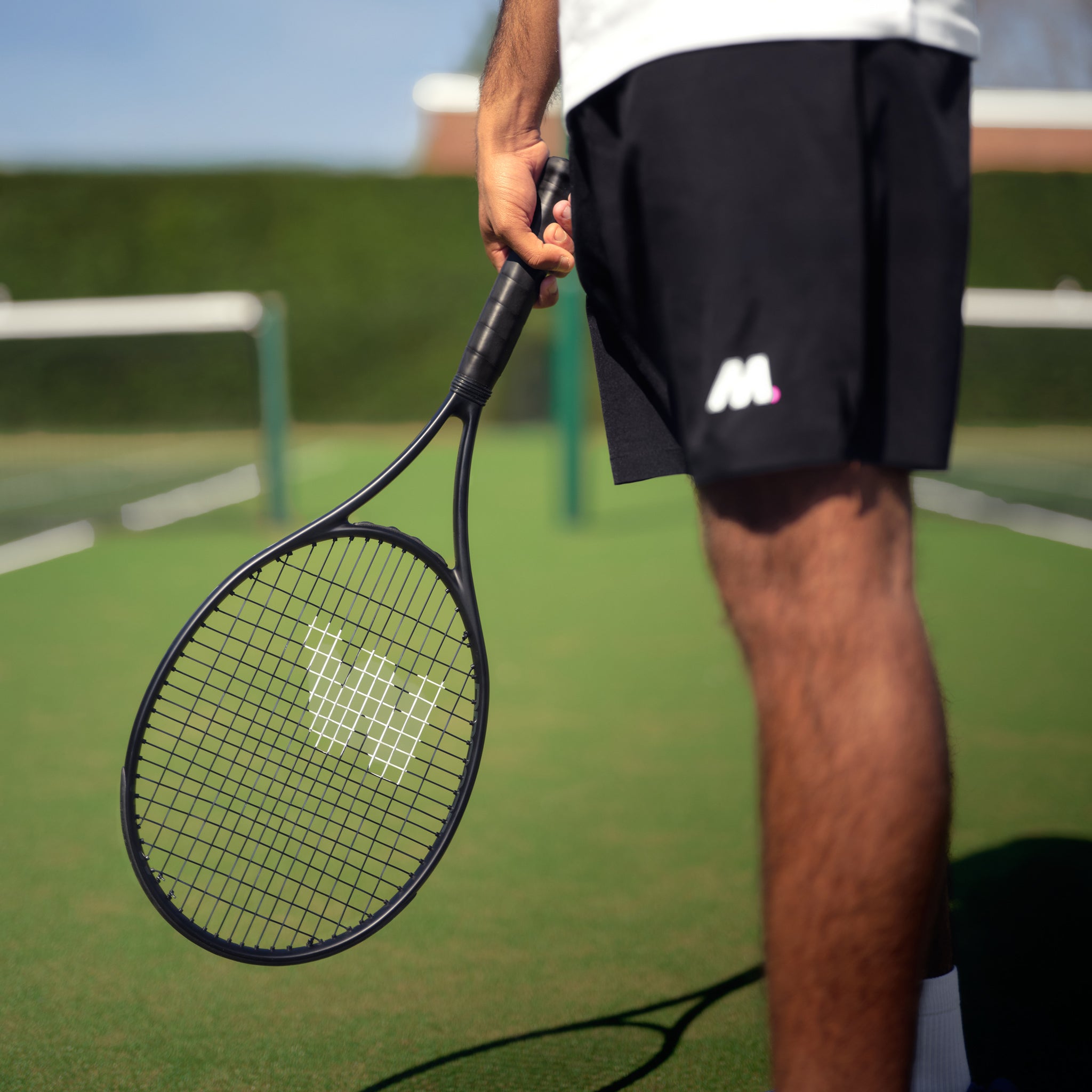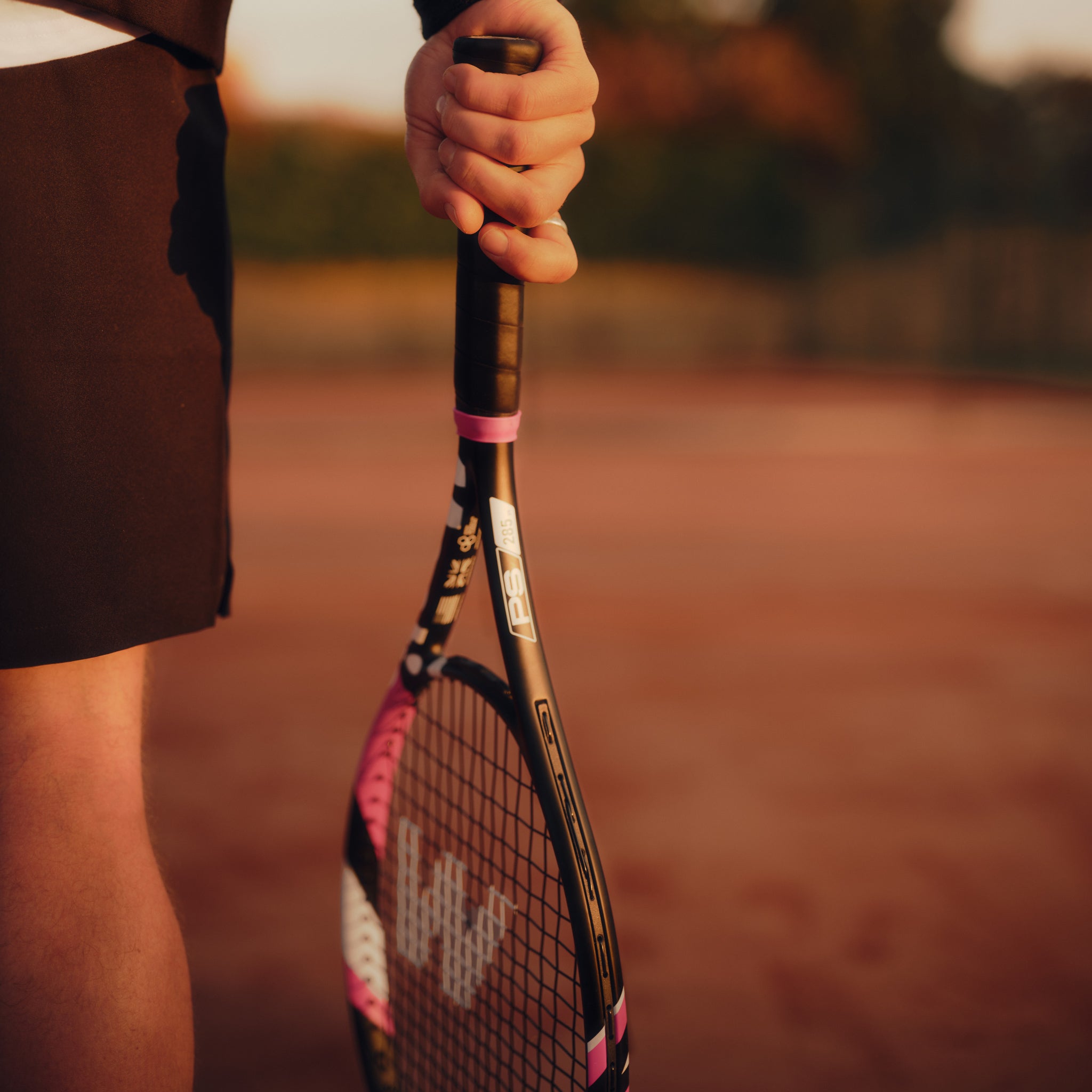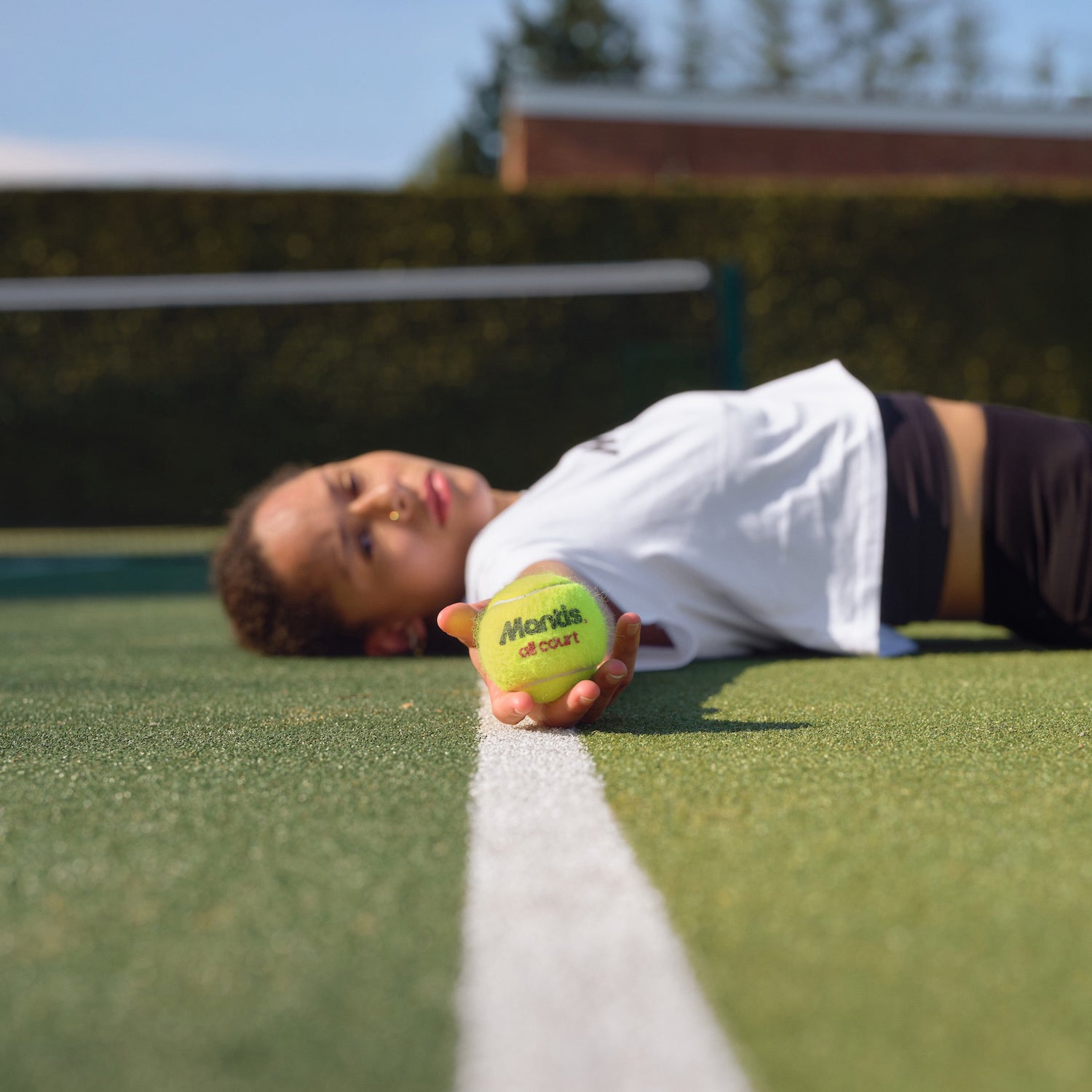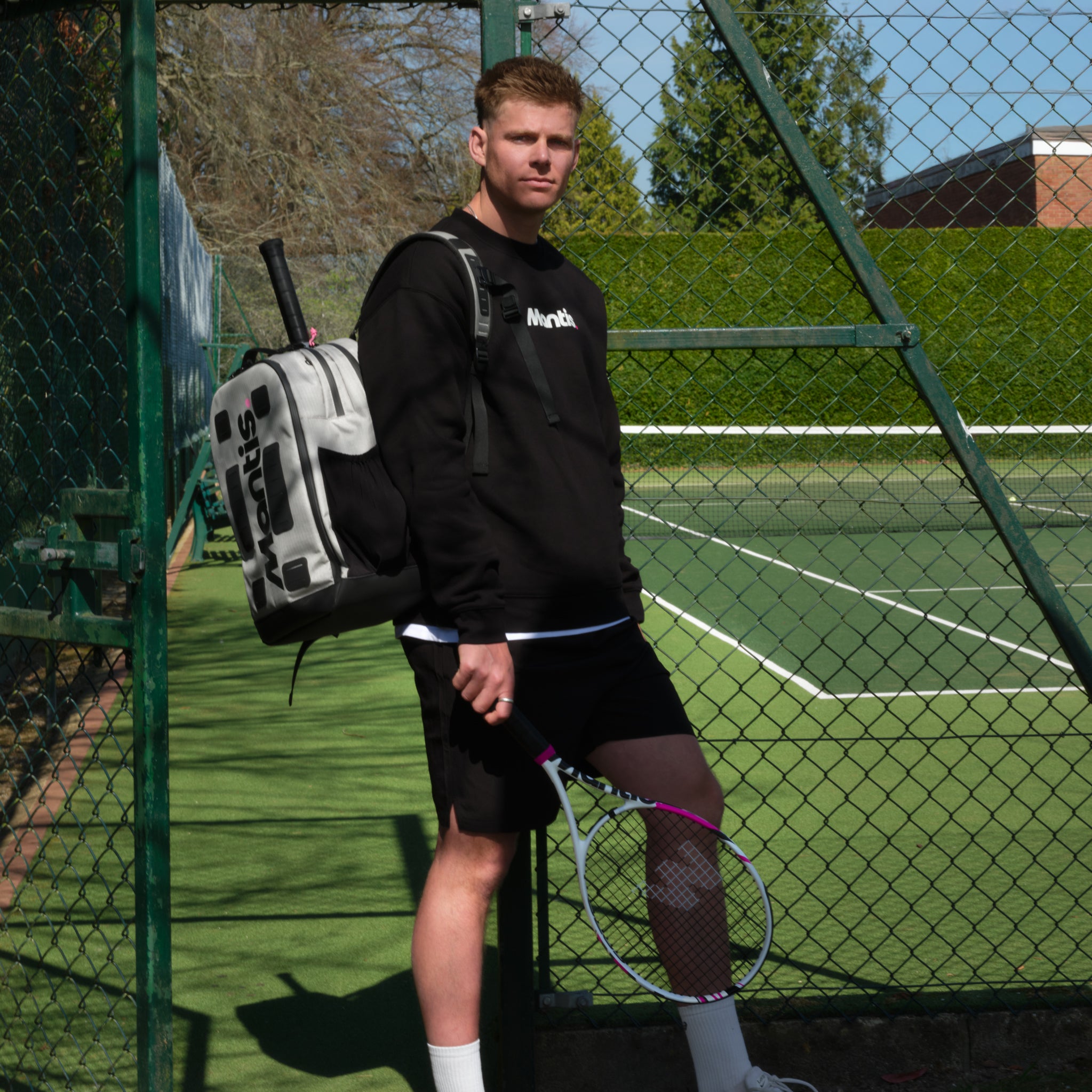
Before you can even think about hitting a forehand, you need to get the basics sorted once you've decided to learn to play tennis. That means picking out the right gear, finding a court, and getting your head around the rules. It might not sound as exciting as a rally, but believe us, starting with a beginner-friendly racquet, proper shoes, and comfy clothes is the first step to making your time on court fun and safe. For a proper deep dive into choosing your most important bit of kit, have a read of our detailed guide on how to choose a tennis racket.
Getting Started on Your Journey To Learn to Play Tennis
Starting a new sport can feel a bit daunting, but here at Mantis, we believe the journey from the sidelines to the baseline should be straightforward and enjoyable right from the start. That journey begins before you even step on a court, with a couple of key decisions about your equipment.
Getting these fundamentals right makes a world of difference, turning what could be a frustrating experience into one you’ll love. For a proper deep dive into choosing your most important bit of kit, have a read of our detailed guide on how to choose a tennis racket.
Choosing the right equipment is your first win. A classic mistake beginners make is grabbing a racquet that looks like what the pros use—often too heavy, with a tiny head size. This usually just leads to a lot of mishits and a much steeper learning curve. Instead, your focus should be on gear that's actually designed to help you improve.
Selecting Your First Racquet
Your first racquet should be your best mate on the court: forgiving and easy to handle. Look for one with a larger head size, something around 100 square inches or more. This gives you a bigger ‘sweet spot’, making it much easier to make clean contact with the ball.
A lighter frame is also a game-changer. It allows you to swing more freely and helps you avoid getting tired while you're still building up your strength and getting the hang of the technique.
Don’t forget about grip size, either. Playing with the wrong size can really hold you back and can even lead to injuries like tennis elbow. A quick measurement is all it takes to find the right fit, giving you the comfort and control you need to learn the basic strokes.
Your Essential Beginner Tennis Gear
While the racquet usually gets all the limelight, the rest of your gear is just as vital for keeping you safe and helping you play your best. This table breaks down what you'll need to get started.
| Gear Item | What to Look For as a Beginner | Why It Matters |
|---|---|---|
| Tennis Racquet | Large head size (100+ sq. in.), lightweight frame, correct grip size. | A bigger sweet spot makes it easier to hit the ball, and a light frame prevents fatigue while you learn. |
| Tennis Shoes | Designed for lateral movement with non-marking soles. | They provide crucial ankle support for side-to-side shuffling and are required on most courts. |
| Apparel | Lightweight, breathable, moisture-wicking materials. | You'll be moving a lot, so you need clothes that won't restrict you and will keep you cool. |
| Tennis Balls | Lower-compression "beginner" balls (often green, orange, or red). | They bounce lower and fly slower, giving you more time to get into position and hit the ball. |
Getting this kit sorted from day one sets a solid foundation for your game.
Finding a Place to Play
Once you've got your gear, you need a court. Luckily, in the UK, you've got plenty of options. Many local parks have courts that are either free or very cheap to book, which is perfect when you're just starting out.
If you’re looking for something a bit more organised, check out local tennis clubs. The LTA (Lawn Tennis Association) has a brilliant online court finder on their website that helps you find facilities near you. It’s never been easier to get on court and start hitting.
Mastering the Four Basic Tennis Strokes
Right, you've got the gear. Now for the fun part: actually hitting the ball.
To get going in tennis, you really need to get to grips with the four fundamental strokes. They're the building blocks for everything else you'll do on court. At Mantis, we're big believers in mastering the forehand, backhand, volley, and serve right from the start. Get these down, and you'll be set up for a lifetime of enjoying the game.
Think of these strokes as the language of tennis. We're going to break each one down into simple, manageable pieces to help you build that crucial muscle memory. This way, you'll develop a reliable technique you can trust when the pressure's on, sidestep common beginner pitfalls, and get playing proper points much sooner.
The Reliable Forehand Groundstroke
For most people, the forehand feels the most natural. It's usually the first shot you learn because the swinging motion is pretty intuitive. The aim here is to develop a smooth, flowing swing that gives you a nice blend of power and control, letting you hit the ball with confidence from the back of the court.
A solid forehand relies on a few key things working in harmony. Your grip is the first step; most beginners find the semi-western grip is a comfortable and versatile place to start. From there, it's all about your swing path and how you use your body.
We see it all the time with new players – they try to swing using just their arm. Real power and consistency come from the whole body. You need to rotate your hips and shoulders to drive through the ball, not just swat at it.
To build a forehand you can count on, think of the swing in three distinct phases:
- The Preparation: As you see the ball coming, turn your body sideways and draw your racquet back in a loop. This "unit turn" gets your core involved and primes your body to unleash some power.
- The Swing Path: Your swing should travel from low to high. A great mental image is to think about brushing up the back of the ball. This is what helps create topspin, giving you better control and making the ball dip nicely into the court.
- The Follow-Through: Don't stop your racquet dead after you've hit the ball. Let the momentum carry it up and across your body, finishing somewhere over your opposite shoulder. This ensures a full, relaxed swing and helps you stay balanced for the next shot.
Choosing Your Backhand Style
The backhand can feel a bit awkward at first, but with the right technique, it can become just as dependable as your forehand. The first big choice you'll face is whether to go for a one-handed or a two-handed backhand. There's no right or wrong answer here; it really boils down to what feels right for you, your strength, and your comfort.
Most coaches will get beginners started with a two-handed backhand. Using both hands gives you a lot more stability and makes it easier to keep the racquet face steady through the point of contact. It’s especially helpful if you haven't yet built up the wrist and forearm strength needed for a one-hander.
That said, the one-handed backhand offers a bit more reach and, once you've mastered it, can open up a world of slice and variety. It definitely has a steeper learning curve, but some players just find its classic, fluid motion more comfortable in the long run. The best advice? Have a go at both when you first start practising and see which one clicks.
Controlling the Net with Volleys
Volleys are the shots you hit up at the net before the ball has a chance to bounce. They demand quick reflexes and a very compact motion. Forget about power here; volleys are all about precision, placement, and putting the point away.
The technique is much shorter and sharper than a groundstroke. Think of it more as a firm "punch" or a "block" than a full swing. You're basically using your opponent's pace against them, redirecting the ball into an open space. Remember to keep your racquet head up and out in front of you, get into a wide, stable stance, and step into the shot to maintain control.
Building a Consistent Serve
The serve is, without a doubt, the most important shot in tennis. Why? Because it's the only one you have complete and utter control over. A reliable serve can put you on the front foot in a rally from the very first ball.
It's a complex motion, for sure, but breaking it down makes it far less daunting. Your main goal should be to develop a smooth, repeatable rhythm, not to hit the ball as hard as you can. A consistent serve hit at 60% of your maximum power is infinitely more effective than a wild, all-or-nothing attempt at 100% that rarely goes in.
Getting Your Footwork and Court Positioning Right
Having a beautiful forehand is one thing, but if you can't get to the ball in time to hit it, that perfect technique won't do you much good. This is where footwork comes in. Efficient movement is the engine that drives a solid tennis game, yet it's something so many beginners overlook in favour of hitting drills.
Here at Mantis, we believe great footwork isn’t just about raw speed. It’s about balance, anticipation, and getting back into position for the next shot. For a deeper dive into improving your on-court agility, take a look at our guide on essential tennis footwork drills you can easily practise on your own.
Excellent court movement is really built on a handful of core patterns that keep you ready and help you react in a split second. Getting these movements down will completely change how you control rallies.
Think of your feet as the foundation for every single shot. If you’re off-balance or caught flat-footed, your swing will almost certainly fall apart. The real goal is to make small, quick adjustments so you're always in the best possible position to strike the ball cleanly.
The Essential Movement Patterns
To move effectively, you really only need to master three fundamental movements that every player uses constantly. They aren't complicated, but they are absolutely crucial for covering the court.
-
The Split-Step: This is a small hop you take just as your opponent is about to strike the ball. It lands you on the balls of your feet in a balanced, athletic stance, ready to push off explosively in any direction. Timing this right is a game-changer for your reaction speed.
-
Side-Shuffles: When moving side-to-side along the baseline, side-shuffles are your best friend. They keep your body facing the net, so you stay balanced and prepared to hit. It’s far better than turning and running, which often leaves you tangled up and out of position.
-
Recovery Steps: The moment you've hit your shot, your first thought should be getting back to a neutral position. Use quick crossover steps or shuffles to get back towards the centre of the baseline, ready for whatever comes next.
The best players make movement look effortless because they anticipate. They're not just reacting; they're already on their way to where they think the ball is going to be. It all starts with a well-timed split-step, every single time.
Understanding Basic Court Positioning
Knowing where to stand is just as important as knowing how to move. Your position on the court should change depending on the situation, but there's a simple rule of thumb for beginners to follow.
After most shots from the baseline, your aim is to recover to the centre mark. This little spot effectively bisects the angle of your opponent's possible returns, which means you have the shortest distance to run to cover either side of the court.
Standing here simply gives you the best chance of reaching their next shot, whether it's a cross-court screamer or a sneaky down-the-line pass. This simple principle reduces the amount of frantic sprinting you have to do, helping you conserve energy and stay in control of the point.
How to Build an Effective Practice Routine
Turning all that early enthusiasm into real skill takes more than just turning up to the court; it demands consistent, focused practice. We firmly believe that an effective practice routine is the bridge between knowing the strokes and actually executing them in a game. It’s what gives you the structure to build muscle memory, iron out the kinks in your technique, and see genuine improvement, ensuring every hour you spend on court counts. You can also consult a tennis coach to help guide you in this aspect of learning the game.
A great routine doesn't need to be complicated. The real secret is having a clear plan before you start, mixing things up to keep your sessions engaging and productive. Whether you’re on your own or with a hitting partner, having a structure stops you from just aimlessly hitting balls back and forth.
This just means that every session should have a purpose. Maybe one day your focus is purely on getting that serve motion right, while the next is all about keeping a cross-court rally going.
Structuring a Solo Practice Session
Practising alone is a fantastic way to get your reps in and smooth out technical flaws without the pressure of a proper game. A practice wall or a ball machine can be your best friend here, giving you a steady, consistent feed that lets you focus entirely on your form.
A good solo hit should be balanced and purposeful. Here’s a simple blueprint you can follow and adapt:
- Warm-Up (10 minutes): Start with a light jog and some dynamic stretches to get the body ready. Follow this with gentle mini-tennis rallies against the wall just to find your timing.
- Technique Focus (20 minutes): Pick one stroke and dedicate this block to it. For example, hit 50 forehands in a row, concentrating only on your swing path and follow-through.
- Footwork Drills (15 minutes): Now, combine movement with your hitting. Try shuffling to the side to hit a forehand, then recovering back to the centre before the ball comes back.
- Cool-Down (5 minutes): Always finish with some static stretching to help with recovery and prevent stiffness.
Effective Drills with a Partner
When you’ve got a partner, the focus can shift towards consistency, control, and the basics of playing a point. Partner drills bring in that element of unpredictability, forcing you to react and adapt just as you would in a match.
The goal of partner drills isn't to win the point, but to extend the rally. Consistency is far more valuable for a beginner than trying to hit a spectacular winner on every shot. Keeping the ball in play for 10-15 shots is a huge achievement.
Try working these drills into your next session:
| Drill Name | Objective | How to Do It |
|---|---|---|
| Cross-Court Rally | Develop directional control and consistency. | Both players stand on their deuce side and aim to rally the ball cross-court only. After 10 minutes, switch to the ad side. |
| One-Up, One-Back | Practise transitioning from baseline to net. | One player stays on the baseline while the other starts at the service line. The baseliner feeds balls for the net player to volley. |
| Mini-Tennis Game | Improve touch and control in a smaller space. | Play points just within the service boxes. This forces you to soften your hands and think about placement, not power. |
By blending solo repetition with these interactive partner drills, you’re building a really well-rounded routine. It’s a balanced approach that ensures you’re building both your technical skills and the tactical awareness you need to truly enjoy the game.
Finding Your Place in the UK Tennis Scene
Tennis is as much a social game as it is a physical one. Here at Mantis, we’ve seen countless players come alive once they connect with their local tennis community. It’s what keeps you coming back to the court. The power of learning in a group is well-known, and you can see it in all sorts of successful communities of practice across different fields.
Finding that community is key to staying motivated, whether you decide to join a club or just make the most of the fantastic public park courts we have in the UK. One isn't better than the other; it’s all about what works for you and makes your tennis journey more rewarding.
Clubs Versus Park Courts
A proper tennis club often provides a really structured setup. You’ll find organised social play, internal box leagues, and easy access to LTA-accredited coaching, all in one place. If you love the idea of a ready-made community and appreciate having scheduled sessions and playing partners sorted for you, this is a brilliant route to take.
On the other hand, public park courts have never been better. Thanks to some serious investment across the country, they offer amazing flexibility and a much lower-cost way to get into the sport. If your schedule is all over the place or you just prefer a more casual, pay-and-play approach, booking a court at your local park is a fantastic option.
Tapping into the Community
No matter where you choose to play, getting into some group lessons is one of the best things you can do. It’s a great way to meet other beginners and build your confidence in a supportive setting where everyone’s learning together.
The tennis scene in the UK is absolutely buzzing right now. In fact, Great Britain is number one in the world for adult tennis participation per capita, with around 5.6 million of us playing at least once a year. This boom is thanks in large part to ongoing investment in local and park-level tennis, making it easier than ever to pick up a racket. You can read more about the growth of UK tennis from the LTA on their site.
Joining a group or just finding a regular hitting partner transforms tennis from a solo drill into a shared journey. It keeps you accountable, gives you that bit of encouragement, and honestly, just makes the whole thing a lot more fun.
So, whether you go for the structure of a club or the freedom of the park, make an effort to find your people. It will completely change your experience of the game.
Got Questions About Learning Tennis? We've Got Answers
As you start your journey in tennis, it’s completely natural for questions to pop up. At Mantis, we want to help clear up any initial uncertainties you might have. We’ve put together some answers to the queries we hear most often from beginners, hopefully giving you that extra bit of confidence. For more answers and high-quality equipment, visit us at https://mantissport.com.
Getting these things straight early on helps you focus on what really matters—enjoying your time on the court and actually improving.
How Long Does It Take to Get Good at Tennis?
There's no single answer to this, as everyone's progress is different. But with consistent practice—say, one or two sessions a week—most beginners can hold a basic rally within three to six months. This initial phase is all about getting the foundational technique down and feeling comfortable with the movements.
If you're aiming for a solid intermediate level, where you can play competitive matches and think more tactically, you're probably looking at one to two years of regular play.
The real secret is consistent effort over time. A couple of focused hours each week will do far more for your game than one long, infrequent session.
Do I Really Need a Coach to Learn Tennis?
While private coaching offers brilliant, personalised feedback, it's certainly not the only path. Many beginners find that affordable group lessons at local UK clubs or park courts are a fantastic way to master the fundamentals in a fun, social setting.
That said, we believe even a handful of introductory lessons is a smart investment. A good coach can spot and correct bad habits before they take hold—like an incorrect grip—which can be incredibly difficult to unlearn later on.
What’s the Biggest Mistake New Players Make?
Without a doubt, it’s trying to hit the ball with all your might instead of focusing on solid technique and good footwork. We see it all the time. Newcomers often swing using just their arm, which leads to inconsistent shots and can even risk injury.
A proper tennis stroke involves the entire body. Power comes from the ground up, starting with your legs and rotating through your core. Another classic error is waiting for the ball to come to you instead of moving into position before you swing. Concentrate on a smooth, full-body motion and keeping your feet active, and you'll build a much stronger foundation for your game.
Is Tennis a Good Workout?
Absolutely. Tennis is an excellent full-body workout. It does wonders for your cardiovascular health with its constant movement and short, sharp sprints. All that running, stopping, and changing direction builds serious lower-body strength and agility.
Plus, the simple act of swinging a racquet engages your core, back, and arm muscles. It’s a genuinely effective—and enjoyable—way to boost your overall fitness, coordination, and balance.
Ready to put this knowledge into practice? At Mantis, we create expertly crafted racquets and gear designed for players who are serious about improving their game. Find the equipment that matches your ambition. https://mantissport.com








